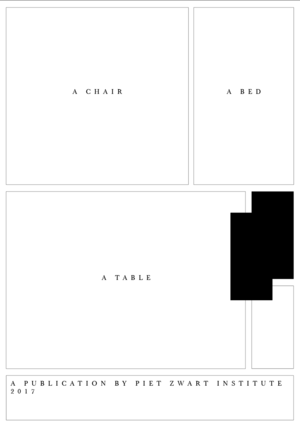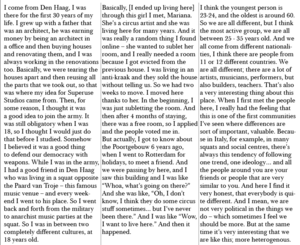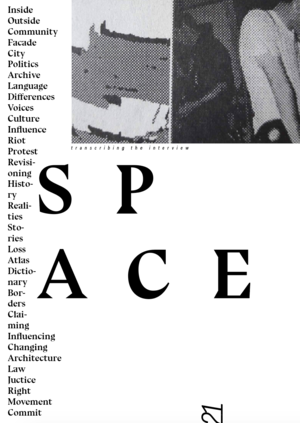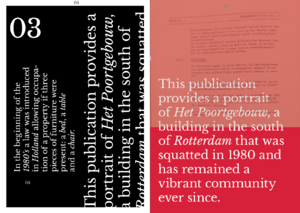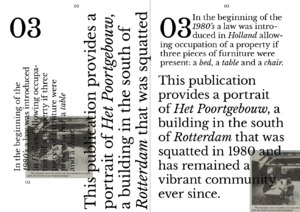Autonomous Archive/hand-curated
Main questions
- Why/How is the Poortgebouw valuable to the city?
- Who is it important for? In what ways?
- How has this changed through the years?
- How can our publication add to this?
- Why is the Poortgebouw worth archiving?
- What is the situation of the PG today? Is there a sense of urgency?
- Why is the autonomous archive important?
- How different are the narratives inside / outside the PG?
Planning
Action Points (Content)
- Define main questions of our publication first draft done
- Make a list of the available archives, where to find them, how to visit them > Joca, finish up 28/09 done
- Make a draft list of questions we want to ask > Angeliki, finish up 02/10 done
- Make a draft list of people we want to interview (inside & outside the PG) > Tash, finish up 02/10 done
- Prepare questions for the meeting at the Poortgebouw 02/10 > Everyone, finish up 01/10 done
- City archive recon > Joca, Alex & Alice, meetup at 11:00 at the Archive (Hofdijk 651, Rotterdam) 29/09 done Pad
- Make a list of topics & search terms for our visit to both City & PG Archive (add them to this pad ) > Everyone, finish up 01/10 done
- Finalise list of questions we want to ask > 05/10 done
- Finalise list of people we want to interview (inside & outside the PG) > 05/10 done
- Visit city archive, scan more documents > 05/10 Joca, done
- Write draft emails, contact people we want to interview > Tash, 06/10 done
- Write email to Giulia about interviewing inhabitants on Saturday > Alice, 06/10 done
- Visit HNI archive Pad with items to request done
- Send email to Katia from HNI. Info archive + interview request. Mail members Feijenoord neighbourhoodcouncil -> Joca done
- Investigate the conditions and practical aspects of the interviews e.g. recording technology, email, skype (their permission to edit) > 06/10 done
- Create our own interview methodology & ethics. Pad > 06/10 done
- Contact PG inhabitants and set up interviews > 09/10 email sent to Giulia
- Research interview methods of
- Laura (Verhalenhuis Belvedere) done
- Siebe Thissen = specialist in "alternative" histories in Rotterdam done
- Teana Boston-Mammah (Storytelling from the City) email sent
- Transcribe Siebe Thissen interview Interview 05/10 > Tash, Alice & Angeliki 09/10 done
- Transcribe Cesare Peeren Interview Pad done
- Transcribe Laura Verhalenhuis interview Interview 09/10 > Tash, Elisa, Angeliki done
- Transcribe Peter and Christine interview Interview 11/10 > Tash, Alice done
- Conduct & transcribe Lidewij Tummers interview Interview 13/10 > Joca, Angeliki
- Conduct & transcribe Marina Otero interview Interview 13/10 > Tash done
- Transcribe Kraakkafe interview Pad > Tash & Joca done
- Conduct & transcribe Katia from HNI Interview 13/10 > Joca, Angeliki done
- Transcribe Giulia interview Interview 14/10 done
- Transcribe Jere interview Interview 14/10 done
- Transcribe Rianne interview Interview 14/10 done
- Conduct & transcribe Ramon Mosterd interview Interview 18/10 done
- Conduct and transcribe Edward Dee interview Pad done
- Make a first draft of the structure of the publication: CHAIR, TABLE, BED done
- Proofread all interviews > 26/10
- Send interview emails to last 3 inhabitants > 26/10
- Make plan for algorithmically curated posters > 26/10
- Draft layout of pages > 26/10
- Conduct interview Feijenoord neighbourhood council Pad with questions Joca, Tash done
- Label parts of each interview into the 3 different chapters
- Make first draft of glossary
- Decide methodology on treating / photographing / copying archive materials
- Sebas interview: https://pad.pzimediadesign.nl/p/interview_PG_Sebas
Research Action Points (Design)
- PG online research
- images
- wiki
- videos
- social media
- PG material research
- posterwall
- archive
- architecture
- who did their graphics before?
- PG inhabitants discussion
- do they want a visual identity?
- references to other designers
- design & politics
- printing
- paper
- binding
- printer
- budget
- technique
- typography
Production Action Points
- layout
- typesetting
- reviewing
- find a printing technique
- find a printer
- prototype
- actual printing
EN summaries of archive items in Dutch
Autonomous_Archive/hand-curated/Summaries_archive_documents
Design Research
Mood
Layout
• Overlapping elements
• Overprinting existing material
• work with (negative) space / moving / influencing spaces
PG = SPACE → INFLUENCE
INFLUENCING SPACE
FLUENT LAYOUT?
Typography
- Edit an existing open source typeface?
- use an open-source typeface
- Libre Baskerville Open Source:
- outside: Classical Typeface (Facade)
- inside: Open-Source (Community)
Some background (maybe helpful)
- Time of PG 1879
- Industrialization
- Eclecticism (architecture)
- Mix of different styles (maybe for layout but also too abstract and not closely related to the issue)
- (Also interesting: Invention of Lithography / Photography in that decade)
- The book goes from manufacture to mass-production
- Time of Squatting 1980
- http://typeandprotest.tumblr.com/
- DTP-Revolution
- Selfmade Posters / Flyers
- simple: mass printing
- simple to publish / spread
→ Libre Baskerville Open Source
Book-Object
Paper
- Ordered Samples from Antalis (Antalis Chromolux (120g)) |
Link to Antalis – Samples arrived
- Update: more samples from Antalis (Munken & Recycling paper)
- Munken Lynx rough
- Cocoon Offset recycled 100g
- Cocoon Offset recycled 120g
- Cyclus recycled 100g
- Cyclus recycled 115g
Binding
• Glue binding easy and cheap at Publication Station
• Thread Binding complicated to do on our own (time-intensive, less accurate if self-made)
Printing-test
How much?
Printing (approx. 140 p, <A5)
- Riso: 80 pages = 40 spreads = 20 masters A3 = 40€ (*200 pieces)
- Laser: 60 pages = 30 spreads = 0,20 colorcopy * 30 = 6€ (*200 pieces)
Binding
- Book–Binding 200 pieces thread-stiched: 900€
- self-made
/// Printers Offerts
Graphius
Price 200 copies: € 1.788,57
Option 2/2
Price 200 copies: € 1.788,57
Option 1/1
Price 200 copies: € 529,67
Drukkerij Raddraaier
B/W:
Oplage 200 expl. € 664,00
Scheduling Design & Production
- 9. Oct – Drafts / Concepts
- 9. Oct – Final outcome presentation: 3 concepts
- 10. Oct – 13. Oct Layout / Type drafts
- 10. Oct – 13. Oct Correction about the final outcome
- 13. Oct Decision on layout
- 16. Oct Printing request / Budget plan
- 16. Oct – 30. Oct Prototyping book + layout
- 30. Oct – Decision on object (paper, binding…)
- 30.Oct – 8. Nov Layout / Typesetting
- 4.Nov – Last Deadline: Editorial report rev.1
- 4.Nov – 5.Nov – Implementation 1
- 6.Nov – Last Deadline: Editorial report rev.2
- 6.Nov – 8.Nov – Implementation 2 / Last layout changes
- 8. Nov & 9.Nov – detail typography
- 10.Nov – Write printing data
- 10. Nov – last deadline passing for print
- 6. Dec – publication launch

